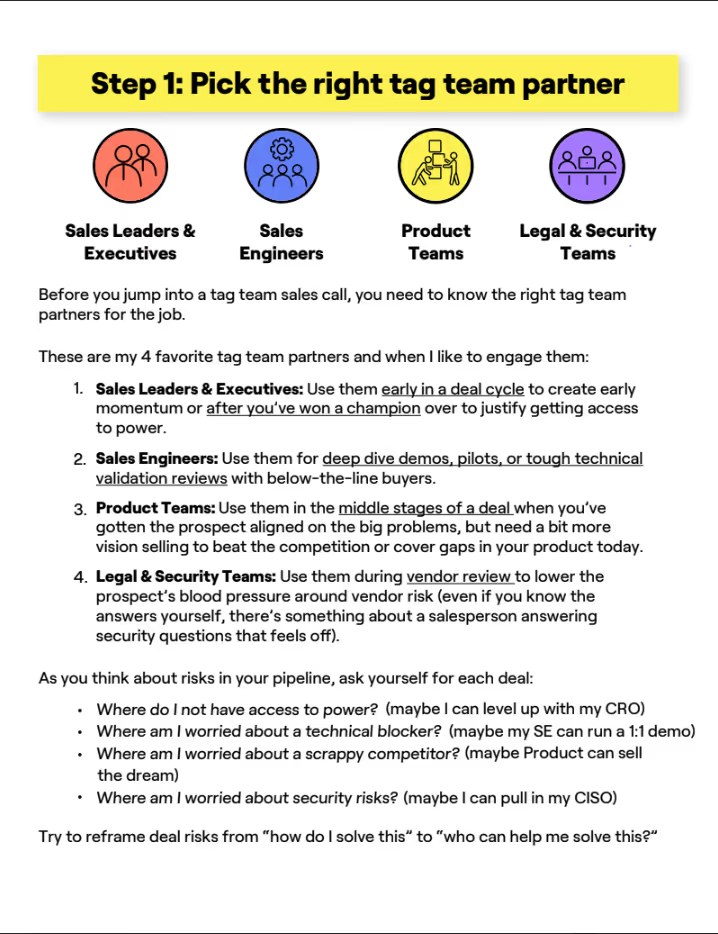
Ah, a great tag team. Gong data shows that team selling can literally boost your win rates by 50% if you bring in 3 or more personas into a deal.
But when team selling goes wrong, it looks like a beginner's salsa class where everyone’s stepping on each other’s toes.
There’s an awkward silence when the AE passes the ball to the product leader. The sales engineer asks the exact same questions the rep asked two calls ago. The sales manager takes over the deal like a super rep.
Your CRO is matching up with their CEO, your product team is getting your champion jazzed up about the vision, your SE is saving you from every technical trap.
When team selling goes right, it looks like a perfectly orchestrated dance performance.
Team selling lets you use executives to get to power, use product to beat the competition, and use sales engineers to disarm traps with technical buyers.
So today, we’re breaking down Three Steps to Tag Team Deals in Sales so that your sales calls don’t look like the first episode of Dancing With The Stars:
- Pick the right tag team partner
- Prime your partner (with a role)
- Run tag team plays on the call
Let's dive in.
Step 1: Pick The Right Tag Team Partner
Before you jump into a tag team sales call, you need to know the right tag team partners for the job. These are my 4 favorite tag team partners and when I like to engage them:
- Sales Leaders & Executives: Use them early in a deal cycle to create early momentum or after you’ve won a champion over to justify getting access to power.
- Sales Engineers: Use them for deep dive demos, pilots, or tough technical validation reviews with below-the-line buyers.
- Product Teams: Use them in the middle stages of a deal when you’ve gotten the prospect aligned on the big problems, but need a bit more vision selling to beat the competition or cover gaps in your product today.
- Legal & Security Teams: Use them during vendor review to lower the prospect’s blood pressure around vendor risk (even if you know the answers yourself, there’s something about a salesperson answering security questions that feels off).
As you think about risks in your pipeline, ask yourself for each deal:
- Where do I not have access to power? (maybe I can level up with my CRO)
- Where am I worried about a technical blocker? (maybe my SE can run a 1:1 demo)
- Where am I worried about a scrappy competitor? (maybe Product can sell the dream)
- Where am I worried about security risks? (maybe I can pull in my CISO)
Try to reframe deal risks from “how do I solve this” to “who can help me solve this?”
Step 2: Prime your partner (with a role)
Even if you bring in the right partner at the right time, you need to be explicitly clear what you want them to do on the call. I assign all of my tag teams one (or multiple) characters to play, with my 4 favorites being:
- The Main Event: You’re responsible for running the bulk of the call. This is common when you bring in SEs for demos or Product for roadmap presentation.
- The Storyteller: You’re responsible for helping us level up in the conversation and engage power. This is great with executives who can use stories to elevate the conversation.
- The Bad Guy: You’re responsible for having the hard conversations. My AEs would bring me in all the time to run the final cuts on the negotiation so that they could preserve goodwill.
- The Room Reader: Your job is to look for trouble because I can’t keep track of everyone. This is best used when you’re running a demo or presentation and you need help keeping everyone in a big room engaged.
From there, if a rep brings me into a deal, I always standardize these 5 questions to prime me on the deal:
- Who’s in the room?
- What’s happened in each deal stage?
- What do we need to get out of this call?
- What role do you want me to play?
- What is your agenda for this call?
Got my role? Got my primer? Now we’re ready to run some plays.
Step 3: Run Tag Team Plays
This is where it gets fun. When everyone knows their job, you can focus on orchestrating the symphony and adapting your call strategy as it plays out. These are 3 of my favorite “tag team plays” that I use on calls:
- The Question Elevator: If I’m the VP joining my AE’s sales call, I’ll often jump in when I feel like there’s something we should’ve dug into deeper. I’ll ask 1-2 questions, then before I finish my last one, I'll DM the rep “back to you” so they can pick up the conversation thread at a higher altitude.
- The Discovery Callback: If an SE is running a demo or if Product is running a roadmap presentation, it’s your job as an AE to connect the demo back to discovery (“Jane, you mentioned this was something that was really frustrating in our last call…”)
- The Story Baton Pass: I’d run this all the time with our CEO. Before I enter a demo riff, I’d say “Matt’s got a good take on this one” so that he knows it’s coming, then I’d do the demo riff and pause for him to jump in.
While it’s preferred to cue your partner into a play through your words, sometimes you have to use Slack or DMs when absolutely necessary (ie: “POWER ISN’T PAYING ATTENTION” would be really awkward to say in front of the customer).
I like to standardize a few Slack codes for common plays – for example, I’d often say “pull up” if the conversation was getting too far in the weeds or “back to you” if I used a question elevator and wanted them to take it from there. Try to avoid walls of text and constant pinging – it’s extremely distracting and frankly a lot of prospects notice.
What Happens Next?
There's one last step: once you get multithreaded STAY multithreaded.
That means debriefing with your team, sending individualized recaps, but then calling on your team later in the deal to keep team selling all the way through the deal.
That's a bit long for me to cover in this noozy, but if you want the step-by-step breakdown on that, I covered the final step in the full guide with our good friends at Otter.ai 👊

















